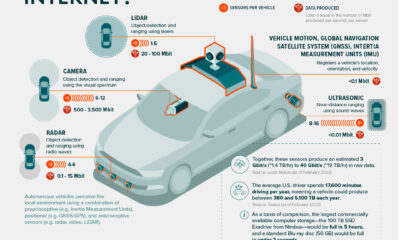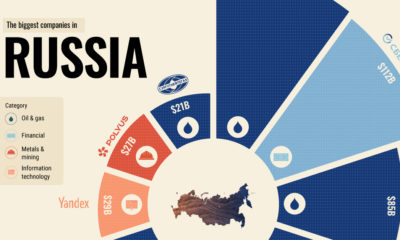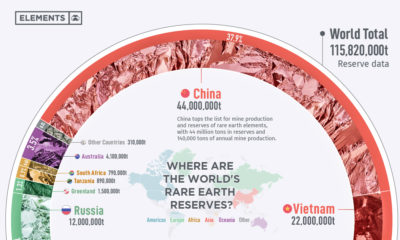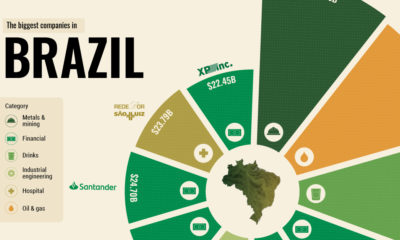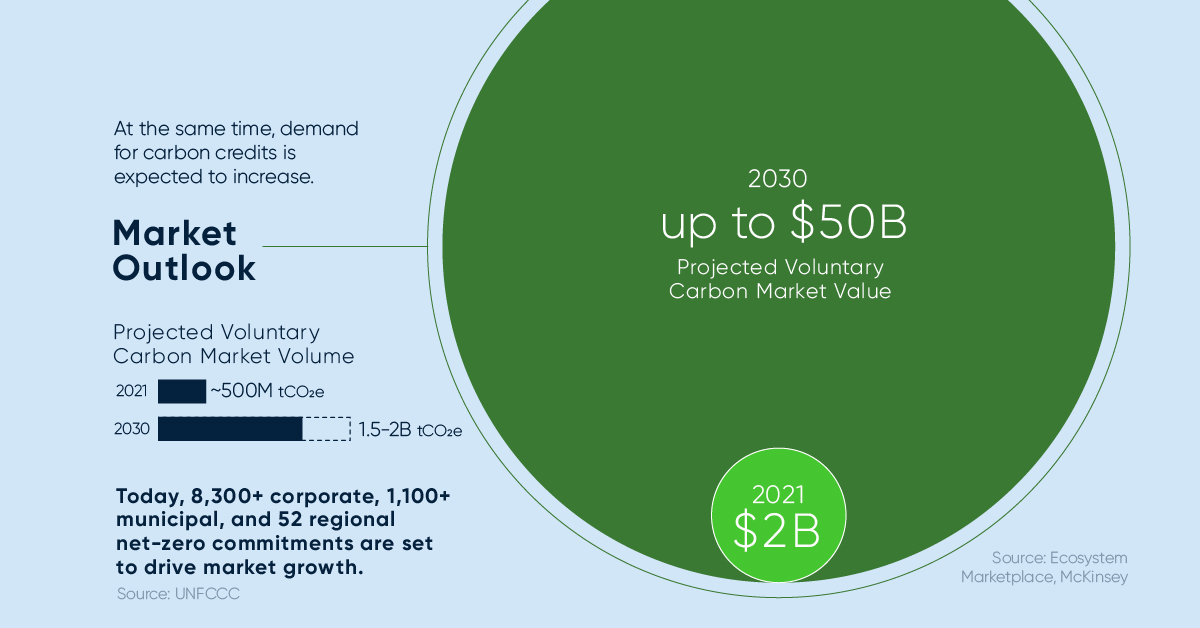The Industrial Internet and How It Is Revolutionizing Mining
Today’s infographic was done in conjunction with GE Digital The Industrial Internet is the convergence of the global industrial sector with big data and the internet of things. Big Data: New insight to make decisions in real-time is made possible by combining the ability to process and make sense of large amounts of data with a universally standard industrial platform. Internet of Things: By 2020, 50 billion devices will be connected to the web. Many of these will be sensors, which can now be produced at a lower cost, creating new levels of network connectivity between machines and people. The result of this convergence will be up to a $15 trillion increase in global GDP over the next 20 years stemming from smarter decisions, optimized performance, higher productivity, and substantial savings in fuel and energy.
How the Industrial Internet works
The Industrial Internet encompasses vast amounts of the complex physical machinery and processes that make our world work. It costs trillions of dollars each year to run these intensive systems. That’s why improving efficiency by just 1% can create millions in cost savings. For example: the combined operating expenditures for the Top 40 miners in 2014 were $531 billion. 1% of that is $5.3 billion in potential savings. Examples of the Industrial Internet in motion:
Predictive analytics warn airline operators of potential engine failures before they occur, saving millions by avoiding downtime and flight delays Driverless haul trucks will soon be the new norm for miners around the world. These robots are more efficient, and are controlled remotely from hundreds of miles away. Drivers and engineers can get real-time reporting on a train as it is in transit. Analytics calculate engine temperature, fuel efficiency, speed, weight, and vibration patterns. The location is tracked to optimize the efficiency of the entire system. By consolidating all the mill asset and process information in a common platform, a mining production manager can see the whole picture. As a result, she knows where the team needs to focus to maximize throughput, recoveries, and quality.
When Hardware Meets Software
The revolution in data analytics and connectivity is changing how people work with heavy-duty machines around the globe, and mining is no exception. Major mining companies have all started to incorporate big data into operations through the industrial cloud. This allows them to avoid unplanned downtime, to act in the best interest of shareholders by converting insights into outcomes, and to use the best available technology. Using predictive analytics and process optimization, the industrial internet can save miners millions of dollars each year. Here are just some examples of the minimum potential savings from a given asset per year using predictive analytics:
Crusher: $119,000 Pump: $62,000 Mill: $312,000 Haul truck: $62,000
Here are just some examples of the minimum potential savings gained per year by optimizing entire processes:
Flotation: $1.6 million Grinding: $0.7 million Surge: $0.2 million 50 PID Loops: $1.5 million
Case Study
The senior metallurgist of a platinum mining company had a problem: the milling circuits were processing more and more waste material together with ore from the main reefs, causing significant operational issues. Even though the different sources were blended, the characteristics of the ore being fed to the mill changed dramatically, often in the space of minutes. This led to extreme variability in the circuit. The Challenge: The company believed that it was losing potential revenue as a result of sub-optimal throughput and efficiency in the milling circuits. The Action: Implemented GE’s Mine Performance solution for process optimization on one of the milling circuits, to stabilize the circuit and optimize throughput. The Results:
Increased average throughput by more than 5.5% Decreased power consumption per ton of material fed by almost 2% Decreased density variation of the cyclone feed
on To reach net-zero by 2050, immediate action and $9.2 trillion in annual investment is required, or about 7-9% of global GDP. This would be $3.5 trillion annually more than today, which in 2020 was equal to roughly:
50% of corporate profits25% of tax revenues7% of household spending
This infographic sponsored by Carbon Streaming Corporation shows how carbon credits can help accelerate a net-zero future by funding climate action.
Closing the Funding Gap With Carbon Credits
Carbon credits play a vital role in channelling finance to help close this funding gap. Here are some ways in which carbon credits can be used: Thanks to a growing number of initiatives listed below, 2023 is anticipated to bring greater credibility and transparency to the carbon credit market.
The Integrity Council for the Voluntary Carbon MarketScience Based Targets initiative (SBTi)Climate Action Data TrustVoluntary Carbon Markets Integrity Initiative
Not Every Carbon Credit is Equal
Identifying high-quality carbon credits is important because not every type of credit offers the same scope of benefits. Carbon credit buyers look for credits that offer tangible benefits that go beyond CO₂ reduction or removal, such as:
Advancing Sustainable Development GoalsCreating jobs in local communitiesProtecting biodiversityProviding education and job training
Often, credits that offer these types of benefits command a price premium. At the same time, demand for carbon credits is expected to increase. Within the decade, the value of the voluntary carbon market could grow from $2 billion up to $50 billion. Voluntary carbon markets refer to the transactions in which carbon credits are purchased by corporate and other buyers that voluntarily (not required by a regulatory act) want to compensate for their emissions or advance sustainability goals.
Source: Ecosystem Marketplace, McKinsey, UNFCCC Today, over 8,300 corporate, 1,100 municipal, and 52 regional net-zero commitments are set to drive market growth.
Carbon Streaming’s Innovative Approach to Climate Action
Carbon Streaming is a publicly listed company that invests capital in high integrity carbon credit projects on a global scale. It uses the proven, flexible streaming model to create long-term partnerships. This model aligns interests to benefit all stakeholders. Carbon Streaming’s growing portfolio of carbon credits includes over 20 projects across six different project types in 12 countries that aim to accelerate a net-zero future.
Transformative Year Ahead
By the end of 2023, carbon credits are expected to be issued from 10 or more projects. Importantly, all of Carbon Streaming’s carbon projects aim to advance multiple UN Sustainable Development Goals. Carbon Streaming intends to continue growing and diversifying its portfolio while selling carbon credits received to maximize value for all stakeholders.
Interested in learning more about Carbon Streaming? Click here to learn more.

